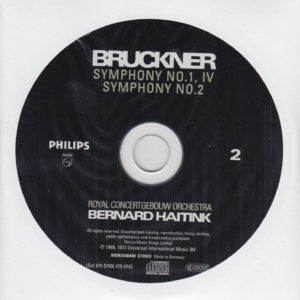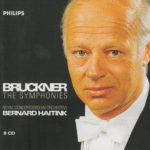 This morning’s conductor of Anton Bruckner’s Symphony No. 2 in C Minor (WAB 102) is Bernard Haitink (1929-), a Dutch conductor and former violinist. I first encountered Mr. Haitink on Day 5 of my 144-day journey.
This morning’s conductor of Anton Bruckner’s Symphony No. 2 in C Minor (WAB 102) is Bernard Haitink (1929-), a Dutch conductor and former violinist. I first encountered Mr. Haitink on Day 5 of my 144-day journey.
On that day, I discovered Mr. Haitink conducted his first concert in 1954 – 62 years ago.
I also discovered that Mr. Haitink conducts a very fine orchestra with the end result being an overall listening experience that catches my attention every time.
First up, the objective aspects of this recording:
Bruckner’s Symphony No. 2 in C Minor, composed in 1872
Bernard Haitink conducts
Royal Concertgebouw Orchestra plays
The version used is, I think, the first version – Haas Edition
The symphony clocks in at about 59 minutes
This was recorded in 1969 in Amsterdam
Haitink was 40 when he conducted it
Bruckner was 48 when he composed it
It was released on the Philip Music Label
 Bruckner wrote his symphonies in four parts. The time breakdown of this one (Symphony No. 2 in C Minor, 1872 Haas Edition), from this particular conductor (Haitink) and this particular orchestra (Royal Concertgebouw Orchestra) is as follows:
Bruckner wrote his symphonies in four parts. The time breakdown of this one (Symphony No. 2 in C Minor, 1872 Haas Edition), from this particular conductor (Haitink) and this particular orchestra (Royal Concertgebouw Orchestra) is as follows:
Allegro……………17:49
Adagio……………15:18
Scherzo……………8:19
Finale………………17:21
Haitink’s Scherzo is a bit brisker – by about two minutes – than Gielen’s (from yesterday). But the two performances are about the same otherwise: 58:07 for Haitink versus 60:39 for Gielen. What’s two minutes among friends, eh?
Okay. Now for the subjective aspects to this morning’s listening:
My Rating:
Recording quality: 3 (very noticeable tape hiss that almost sounds like rain falling)
Overall musicianship: 5
CD liner notes: 4 (short essay in English, French, and German)
How does this make me feel: 4
Another spectacular performance by Royal Concertgebouw Orchestra conducted by Bernard Haitink!
However, the pizzicato and French horn passages (Adagio – Movement II) that blew me away yesterday just kind of lied there this morning. It wasn’t as magical or inspired. Or maybe it wasn’t recorded the same way. Something about it wasn’t the same. Here’s what I wrote yesterday:
For example, around the 7:38 mark of Movement II (Adagio), there’s a very pleasant passage that features pizzicato. I love pizzicato (that’s the Italian word to describe the plucking of stringed instruments). It reminds me of cartoon characters trying to sneak up on each other. A solo French horn enters at the 7:42 mark and provides a beautiful counterpoint melody that creates an exceptionally joyful listening experience, especially throughout the rest of the movement as strains of the French horn’s melody are replayed. (I love French horn, especially as played by the late English horn player Dennis Brain – talk about magical!)
This morning that same passage (which is a repeat of when it first appears at the 2:25-2:57 mark in Movement II) didn’t move me the same way. I listened to both appearances of that pairing of pizzicato and French horn – two minutes in and seven minutes in – in both performances. First, Haitink. Then Gielen.
The difference is the French horn.
The player in the Gielen recording has a warmer, smoother tone than the player in the Gielen recording. Plus, both strings and horn are mic’ed differently. The Gielen recording has them mic’ed more clearly, more up front. The Haitink recording has them back a little more.
It’s probable that if I wasn’t such a freak for both pizzicato and French horn that I wouldn’t have noticed. But those sounds always grab my attention. Plus, my wife used to play French horn. So I’m keen on paying attention to its sound. After all, she’s the one who introduced me to Dennis Brain.
The Haitink performance is bright, dynamic, and well performed. It’s not as captivating to my ears as the Gielen performance was yesterday. But, still, if I had to introduce a friend to Bruckner’s Symphony No. 2 in C Minor I wouldn’t hesitate to recommend he or she start with Haitink’s interpretations.
